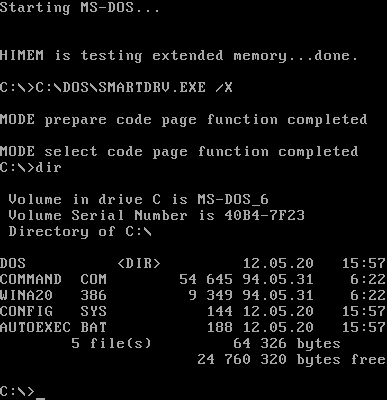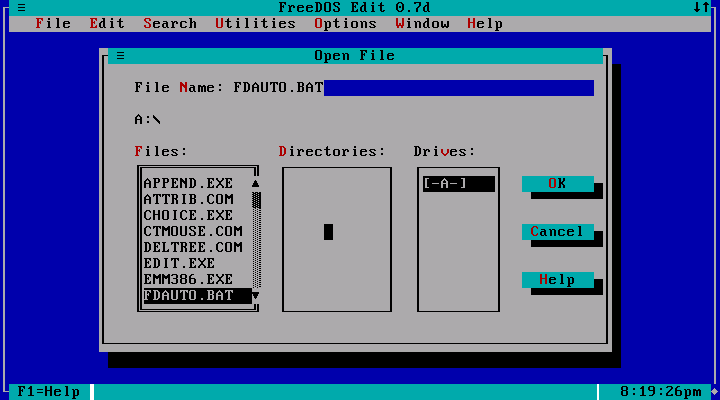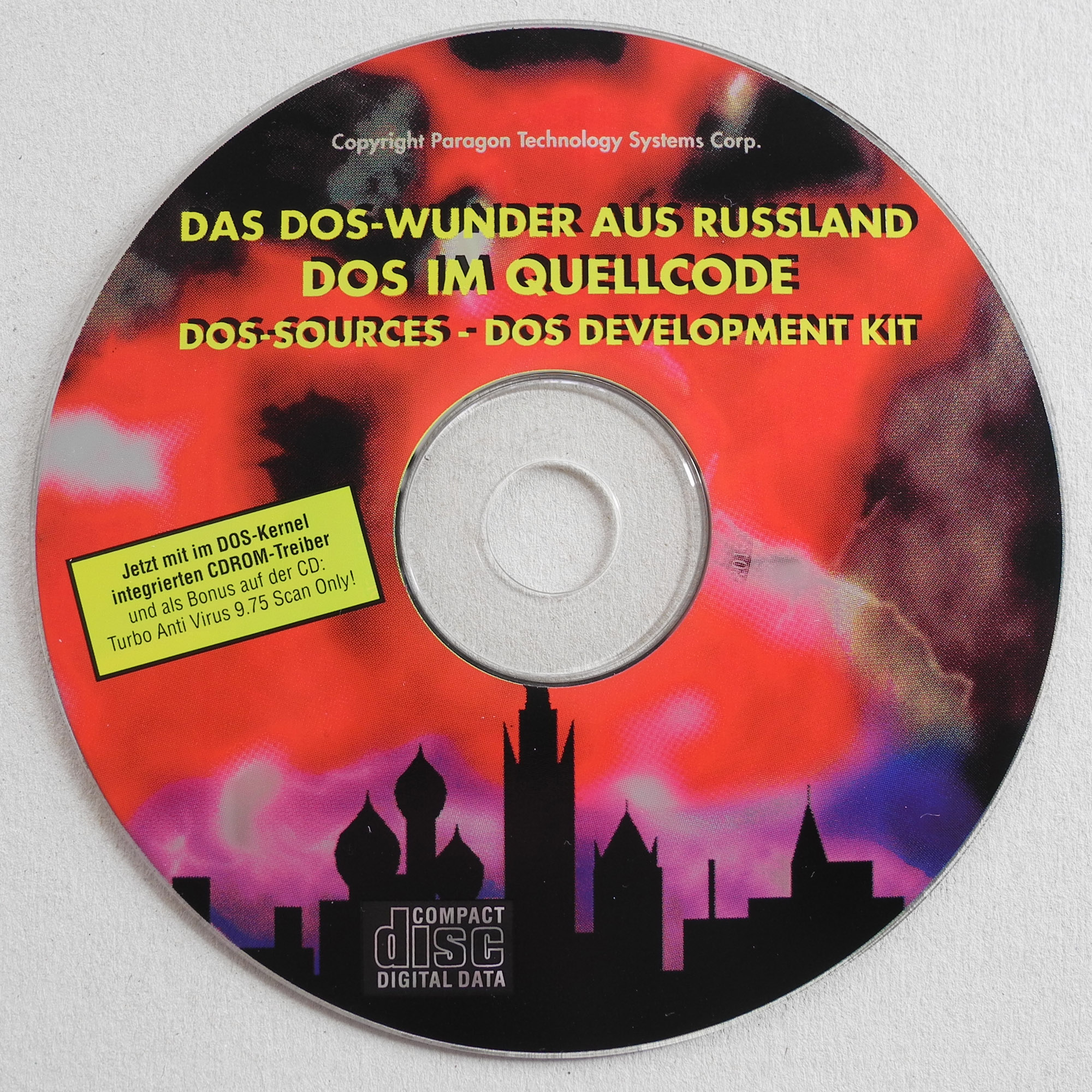|
DOS
DOS (, ) is a family of disk-based operating systems for IBM PC compatible computers. The DOS family primarily consists of IBM PC DOS and a rebranded version, Microsoft's MS-DOS, both of which were introduced in 1981. Later compatible systems from other manufacturers include DR-DOS (1988), ROM-DOS (1989), PTS-DOS (1993), and FreeDOS (1994). MS-DOS dominated the IBM PC compatible market between 1981 and 1995. Although the name has come to be identified specifically with MS-DOS and compatible operating systems, ''DOS'' is a platform-independent acronym for ''disk operating system'', whose use predates the IBM PC. Dozens of other operating systems also use the acronym, beginning with the mainframe DOS/360 from 1966. Others include Apple DOS, Apple ProDOS, Atari DOS, Commodore DOS, TRSDOS, and AmigaDOS. History Origins IBM PC DOS (and the separately sold MS-DOS) and its predecessor, 86-DOS, ran on Intel 8086 16-bit processors. It was developed to be sim ... [...More Info...] [...Related Items...] OR: [Wikipedia] [Google] [Baidu] |
DR-DOS
DR-DOS is a disk operating system for IBM PC compatibles, originally developed by Gary A. Kildall's Digital Research, Inc. and derived from Concurrent PC DOS 6.0, which was an advanced successor of CP/M-86. Upon its introduction in 1988, it was the first DOS that attempted to be compatible with IBM PC DOS and MS-DOS. Its first release was version 3.31, named so that it would match MS-DOS's then-current version. DR DOS 5.0 was released in 1990 as the first to be sold in retail; it was critically acclaimed and led to DR DOS becoming the main rival to Microsoft's MS-DOS, who quickly responded with its own MS-DOS 5.0 but releasing over a year later. It introduced a graphical user interface layer called ViewMAX. DR DOS 6.0 was released in 1991; then with Novell's acquisition of Digital Research, the following version was named Novell DOS 7.0 in 1994. After another sale, to Caldera, updated versions were released partly open-source under the Caldera moniker, and briefly as ... [...More Info...] [...Related Items...] OR: [Wikipedia] [Google] [Baidu] |
MS-DOS
MS-DOS ( ; acronym for Microsoft Disk Operating System, also known as Microsoft DOS) is an operating system for x86-based personal computers mostly developed by Microsoft. Collectively, MS-DOS, its rebranding as IBM PC DOS, and a few operating systems attempting to be compatible with MS-DOS, are sometimes referred to as "DOS" (which is also the generic acronym for disk operating system). MS-DOS was the main operating system for IBM PC compatibles during the 1980s, from which point it was gradually superseded by operating systems offering a graphical user interface (GUI), in various generations of the graphical Microsoft Windows operating system. IBM licensed and re-released it in 1981 as PC DOS 1.0 for use in its PCs. Although MS-DOS and PC DOS were initially developed in parallel by Microsoft and IBM, the two products diverged after twelve years, in 1993, with recognizable differences in compatibility, syntax and capabilities. Beginning in 1988 with DR-DOS, ... [...More Info...] [...Related Items...] OR: [Wikipedia] [Google] [Baidu] |
86-DOS
86-DOS (known internally as QDOS, for Quick and Dirty Operating System) is a discontinued operating system developed and marketed by Seattle Computer Products (SCP) for its Intel 8086-based computer kit. 86-DOS shared a few of its commands with other operating systems such as OS/8 and CP/M, which made it easy to port programs from the latter. Its application programming interface was very similar to that of CP/M. The system was licensed and then purchased by Microsoft and developed further as MS-DOS and PC DOS. History Origins 86-DOS was created because sales of the Seattle Computer Products 8086 computer kit, demonstrated in June 1979 and shipped in November, were languishing due to the absence of an operating system. The only software that SCP could sell with the board was Microsoft's Standalone Disk BASIC-86, which Microsoft had developed on a prototype of SCP's hardware. SCP wanted to offer the 8086-version of CP/M that Digital Research had initially announced fo ... [...More Info...] [...Related Items...] OR: [Wikipedia] [Google] [Baidu] |
IBM PC DOS
IBM PC DOS (an acronym for IBM Personal Computer Disk Operating System),Formally known as "The IBM Personal Computer DOS" from versions 1.0 through 3.30, as reported in those versions' respective COMMAND.COM outputs also known as PC DOS or IBM DOS, is a discontinued disk operating system for the IBM Personal Computer, its successors, and IBM PC compatibles. It was sold by IBM from the early 1980s into the 2000s. Developed by Microsoft, it was also sold by that company to the open market as MS-DOS. Both operating systems were identical or almost identical until 1993, when IBM began selling PC DOS 6.1 with its own new features. The collective shorthand for PC DOS and MS-DOS was DOS, which is also the generic term for disk operating system, and is shared with dozens of disk operating systems called DOS. History The IBM task force assembled to develop the IBM PC decided that critical components of the machine, including the operating system, would come from outside vendors. This r ... [...More Info...] [...Related Items...] OR: [Wikipedia] [Google] [Baidu] |
FreeDOS
FreeDOS (formerly PD-DOS) is a free software operating system for IBM PC compatible computers. It intends to provide a complete MS-DOS-compatible environment for running Legacy system, legacy software and supporting embedded systems. FreeDOS can be booted from a floppy disk or USB flash drive and is designed to run well under virtualization or x86 Emulator, emulation. The FreeDOS project began under Jim Hall (computer programmer), Jim Hall in 1994, and the first Stable version, stable version was released in 2006. Unlike most versions of MS-DOS, FreeDOS is composed of free software, Software license, licensed under the terms of the GNU General Public License. However, other packages that form part of the FreeDOS project include non-GPL software considered worthy of Digital preservation, preservation, such as 4DOS, which is distributed under a modified MIT License. Distribution FreeDOS 1.1, released on 2 January 2012, is available for download as a CD-ROM image: a limited in ... [...More Info...] [...Related Items...] OR: [Wikipedia] [Google] [Baidu] |
FreeDOS Beta 9 Pre-release5 (command Line Interface) On Bochs Sshot20040912
FreeDOS (formerly PD-DOS) is a free software operating system for IBM PC compatible computers. It intends to provide a complete MS-DOS-compatible environment for running legacy software and supporting embedded systems. FreeDOS can be booted from a floppy disk or USB flash drive and is designed to run well under virtualization or x86 emulation. The FreeDOS project began under Jim Hall in 1994, and the first stable version was released in 2006. Unlike most versions of MS-DOS, FreeDOS is composed of free software, licensed under the terms of the GNU General Public License. However, other packages that form part of the FreeDOS project include non-GPL software considered worthy of preservation, such as 4DOS, which is distributed under a modified MIT License. Distribution FreeDOS 1.1, released on 2 January 2012, is available for download as a CD-ROM image: a limited install disc that only contains the kernel and basic applications, and a full disc that contains many more appli ... [...More Info...] [...Related Items...] OR: [Wikipedia] [Google] [Baidu] |
Atari DOS
Atari DOS is the disk operating system used with the Atari 8-bit computers. Operating system extensions loaded into memory were required in order for an Atari computer to manage files stored on a disk drive. These extensions to the operating system added the disk handler and other file management features. The most important extension is the disk handler. In Atari DOS 2.0, this was the File Management System (FMS), an implementation of a file system loaded from a floppy disk. This meant at least an additional RAM was needed to run with DOS loaded. Versions There were several versions of Atari DOS available, with the first version released in 1979. Atari was using a cross assembler with Data General AOS. DOS 1.0 In the first version of DOS from Atari, all commands were only accessible from the menu. It was bundled with the Atari 810 disk drives. This version was entirely memory resident, which made it fast but occupied memory space. DOS 2.0 :Also known as ''DISK OP ... [...More Info...] [...Related Items...] OR: [Wikipedia] [Google] [Baidu] |
TRSDOS
TRSDOS (which stands for the Tandy Radio Shack Disk Operating System) is the operating system for the Tandy TRS-80 line of eight-bit Zilog Z80 microcomputers that were sold through Radio Shack from 1977 through 1991. Tandy's manuals recommended that it be pronounced ''triss-doss''. TRSDOS should not be confused with Tandy DOS, a version of MS-DOS licensed from Microsoft for Tandy's x86 line of personal computers (PCs). With the original TRS-80 Model I of 1977, TRSDOS was primarily a way of extending the MBASIC (BASIC in ROM) with additional I/O (input/output) commands that worked with disk files rather than the cassette tapes that were used by non-disk Model I systems. Later disk-equipped Model III computers used a completely different version of TRSDOS by Radio Shack which culminated in 1981 with TRSDOS Version 1.3. From 1983 disk-equipped TRS-80 Model 4 computers used TRSDOS Version 6, which was a development of Model III LDOS by Logical Systems, Inc. This last was updat ... [...More Info...] [...Related Items...] OR: [Wikipedia] [Google] [Baidu] |
PTS-DOS
PTS-DOS (aka PTS/DOS) is a disk operating system, a DOS clone, developed in Russia by PhysTechSoft and Paragon Technology Systems. History and versions PhysTechSoft was formed in 1991 in Moscow, Russia by graduates and members of MIPT, informally known as PhysTech. At the end of 1993, PhysTechSoft released the first commercially available PTS-DOS as PTS-DOS v6.4. The version numbering followed MS-DOS version numbers, as Microsoft released MS-DOS 6.2 in November 1993. In 1995, some programmers left PhysTechSoft and founded Paragon Technology Systems. They took source code with them and released their own version named PTS/DOS 6.51CD as well as S/DOS 1.0 ("Source DOS"), a stripped down open-source version. According to official PhysTechSoft announcements, these programmers violated both copyright laws and Russian military laws, as PTS-DOS was developed in close relationship with Russia's military and thus may be subject to military secrets law. PhysTechSoft con ... [...More Info...] [...Related Items...] OR: [Wikipedia] [Google] [Baidu] |
Apple ProDOS
ProDOS is the name of two similar operating systems for the Apple II of personal computer. The original ProDOS, renamed ProDOS 8 in version 1.2, is the last official operating system usable by all 8-bit Apple II computers, and was distributed from 1983 to 1993. The other, ProDOS 16, was a stop-gap solution for the 16-bit Apple II that was replaced by GS/OS within two years. ProDOS was marketed by Apple as meaning Professional Disk Operating System, and became the most popular operating system for the Apple II 10 months after its release in January 1983. Background ProDOS was released to address shortcomings in the earlier Apple operating system (called simply DOS), which was beginning to show its age. Apple DOS only has built-in support for 5.25" floppy disks and requires patches to use peripheral devices such as hard disk drives and non- Disk-II floppy disk drives, including 3.5" floppy drives. ProDOS adds a standard method of accessing ROM-based drivers on expansion ca ... [...More Info...] [...Related Items...] OR: [Wikipedia] [Google] [Baidu] |
Apple DOS
Apple DOS is the disk operating system for the Apple II computers from late 1978 through early 1983. It was superseded by ProDOS in 1983. Apple DOS has three major releases: DOS 3.1, DOS 3.2, and DOS 3.3; each one of these three releases was followed by a second, minor "bug-fix" release, but only in the case of Apple DOS 3.2 did that minor release receive its own version number, Apple DOS 3.2.1. The best-known and most-used version is Apple DOS 3.3 in the 1980 and 1983 releases. Prior to the release of Apple DOS 3.1, Apple users had to rely on audio cassette tapes for data storage and retrieval. Version history When Apple Computer introduced the Apple II in April 1977, the new computer had no disk drive or disk operating system (DOS). Although Apple co-founder Steve Wozniak designed the Disk II controller late that year, and believed that he could have written a DOS, his co-founder Steve Jobs decided to outsource the task. The company considered using Digital Research's CP/M, but ... [...More Info...] [...Related Items...] OR: [Wikipedia] [Google] [Baidu] |






